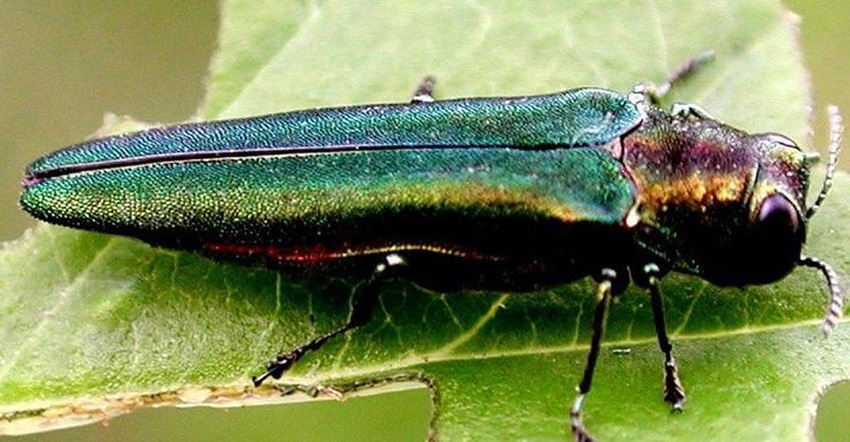
Emerald ash borer is continuing to spread in Iowa. A destructive pest of ash trees, the invasive insect has now been confirmed in Buchanan, Hamilton, Hardin and Pottawattamie counties. The Iowa Department of Agriculture says the emerald ash borer, an exotic pest from Asia, was first found in Iowa in 2010 and has now been detected in 61 Iowa counties.
The state ag department announced this latest EAB confirmation June 22. Insect samples were collected from ash trees in Winthrop (Buchanan County), a rural area east of Randall (Hamilton County), Eldora (Hardin County) and Council Bluffs (Pottawattamie County). The samples were submitted to USDA’s Animal and Plant Health Inspection Service, which confirmed them as positive for EAB.
More reports of sick ash trees
The affected ash trees in Buchanan and Hardin counties were on private property, whereas Hamilton and Pottawattamie counties findings occurred in the right-of-way along Interstates 35 and 80, respectively.
“June is typically the time of year we get a surge in phone calls about poorly looking ash trees. We urge people to continue to report suspicious symptoms in counties that are not yet known to be infested,” says Mike Kintner, the EAB and gypsy moth coordinator at the Iowa Department of Agriculture and Land Stewardship. “People can really help minimize the spread of this pest by not giving it a ride in infested firewood between counties or from home to campsite.”
Insects, diseases hitchhike on firewood
Since the dispersal of this beetle by natural flight is limited to only short distances, people serve as the mode of transportation involving longer distances, Kintner says. Beneath the bark in the larval stage, EAB can unknowingly be transported in firewood. Numerous other insects and diseases can also hitchhike in firewood. Iowans are encouraged to use locally sourced firewood, burning it in the same county where it was purchased.
Adult EAB beetles begin to emerge from May to June and can be found throughout the summer. The metallic-green beetle is slender and approximately a half-inch long. After emerging from a tree, the beetle leaves behind a telltale D-shaped exit hole approximately an eighth inch in diameter.
Watch trees for symptoms
EAB-infested ash trees can include branch dieback in the upper crown, water sprouts along the trunk and main branches, vertical bark splits, D-shaped emergence holes, S-shaped tunneling under loose bark, and woodpecker damage. EAB larvae kill ash trees by tunneling under the bark and feeding on the part of the tree that moves nutrients up and down the trunk. Starved trees usually die within two to four years.
State agencies in Iowa continue to track the movement of EAB on a county-by-county basis. Kintner says residents who suspect an EAB infestation in ash trees in their area are encouraged to contact one of the following:
• Iowa Dept. of Agriculture and Land Stewardship, state entomologist office, at 515-725-1470
• Iowa Department of Natural Resources at 515-725-8453
• Iowa State University Extension entomology at 515-294-1101
Guidelines for using insecticide
As of June 22, the treatment window for soil-applied preventive treatment measures (soil injection, soil drench, or granular application) and basal bark sprays has ended. Trunk injections can be done now through the end of August if a landowner is interested in protecting a valuable and healthy ash tree within 15 miles of a known infestation.
Good ground moisture is essential for systemic insecticide movement in a tree. Full details are available in Iowa State University Extension and Outreach publication PM 2084, Emerald Ash Borer Management Options.
To find a certified applicator in your area, download PM 3074. To learn more about EAB and view maps of its distribution, visit iowatreepests.com.
For more information contact any of the following members of the Iowa EAB Team:
• Mike Kintner, IDALS EAB coordinator, 515-745-2877, [email protected]
• Robin Pruisner, IDALS state entomologist, 515-725-1470, [email protected]
• Jeff Goerndt, DNR state forester, 515-725-8452, [email protected]
• Mark Shour, ISU Extension and Outreach entomologist, 515-294-5963, [email protected]
• Tivon Feeley, DNR forest health program leader, 515-725-8453, [email protected]
• Donald Lewis, ISU Extension and Outreach entomologist, 515-294-1101, [email protected]
• Laura Iles, ISU Extension and Outreach entomologist, ISU Plant and Insect Diagnostic Clinic, 515-294-0581, [email protected]
• Jeff Iles, ISU Extension and Outreach horticulturist, 515-294-3718, [email protected]
• Jesse Randall, ISU Extension and Outreach forester, 515-294-1168, [email protected]
About the Author(s)
You May Also Like




